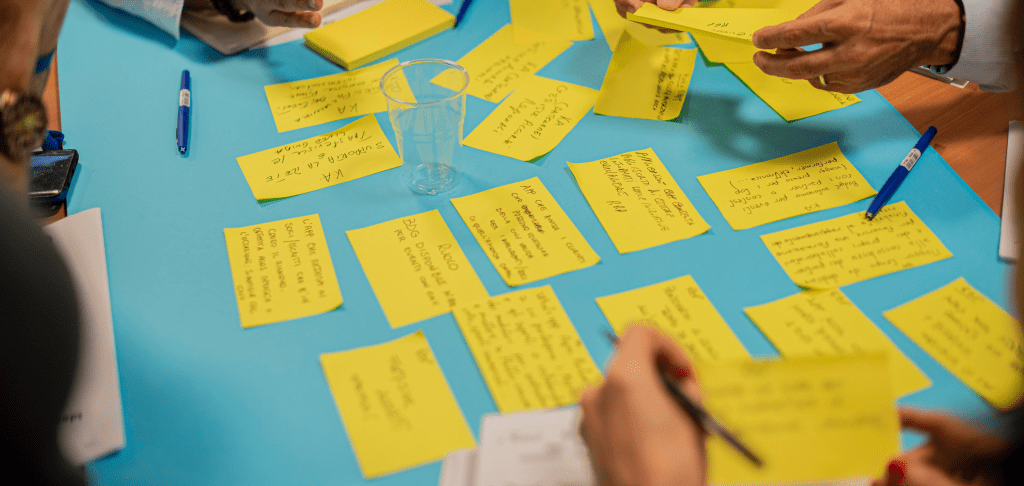Here at ASUS Design Centre Singapore (SADC) we focus primarily on designing and creating innovative products that could improve and enhance our user’s overall PC experience. Part of our innovation and design thinking process is by understanding our users through user design thinking workshops.
 Various Design thinking workshops conducted in ASUS Singapore
Various Design thinking workshops conducted in ASUS Singapore
Conducting design thinking workshops is part of the norm at SADC, where we would come up with potential product ideas by bouncing them off with team members. However, when it comes to creating new products, we have to tread a fine line between proposing innovative ideas and gimmicky ones. To ensure that the new ideas are human-centered, care is taken to include an empathy component during the workshop. Before the pandemic, one of our favorite workshop activities we love to do is the bodystorming workshop.
1. Why bodystorming?
 Images of bodystorming workshop held in ASUS Singapore office
Images of bodystorming workshop held in ASUS Singapore office
We frequently use bodystorming at SADC because it allows us to experience our user’s situations better, inspiring us with thoughtful product ideas. We subject our own bodies to physically experience the user’s environment by acting out and recreating scenarios. The mixture of simulation and role-playing in a physical environment instils a feeling of empathy in us. The workshop outcome aids in the brainstorming process by allowing us to act out or recreate scenarios to generate ideas.
At the start of the workshop, a short immersion phase is conducted in the context of the challenge, where the participants understand the goal, purpose, and more information the roles of various users in a different situation. The key component of having a successful bodystorming workshop is environment replication. At the ASUS Design Centre studio, we would sometimes create recreate the user’s environment in the studio using various tools, accessories, and prototypes.
2. Why IKEA?
Our team needs to balance the workshop goals, time and resources available to plan a successful bodystorming workshop. Using IKEA’s store for the workshop, we have access to the different showrooms to help our designers better understand and empathize with users in a similar environment. Moreover, it is challenging, time-consuming and expensive to recreate multiple home layouts in our studio. Bodystorming at IKEA is great as those involved would ideate by inserting themselves into the environment and experience it from the user’s viewpoint.
3. How we do it?
a. Pre-Workshop

Like all workshop planning, the workshop coordinators, usually helmed by the Design Researchers, outlines the entire workshop plan, goals, personas, and activities. Once the team has ironed out the workshop details, they would head down to IKEA to check out the showroom. During this time, the team would need to evaluate if the current showroom display applies to the workshop personas and their environment. Additionally, the team has to consider possible scenarios in the different showrooms for the workshop participants to use and ideate in. During this time, the design researchers would plan potential scenarios and questions for the bodystorming workshop participants.
As the showroom in IKEA does not have ASUS products or accessories, the team must prepare various mock-ups/prototypes and supporting accessories such as a fake monitor, keyboard, and mouse for the workshop.
Checklist of items needed:
• Facilitator discussion guide + Post it notes
• Pens and markers
• Camera
• Clipboards
• Prototypes: Desktop, Keyboard, Mouse, Monitor
b. Workshop Day
 Briefing the participants prior to the start of the workshop
Briefing the participants prior to the start of the workshop
Before heading down to IKEA, the workshop coordinators would do a quick overview and briefing of the workshop. During this time, they would brief the participants on the objective and goals of the workshop e.g., “To better understand (a specific TA) on how they use (a specific product) in their office or home.” The next part of the briefing is extremely important to the success of the workshop as the participants would need to get familiar and immerse themselves with the various persona background to give good suggestions or ideas during the workshop. The workshop coordinators would do a quick sharing about the personas, their goals and pain points, before heading down to IKEA for the bodystorming workshop.
 Participants engaging in Bodystorming workshop
Participants engaging in Bodystorming workshop
At the showroom in IKEA, the workshop coordinator would “set up” the scene by briefing them on the situation and how the user would be working in the particular “environment”; followed by passing them the relevant props to set up their computer.
The workshop participant bodystorms by would putting themselves into the user’s shoes and recreate the experience with the props. As the participants set up, the workshop coordinators will question them on their rationale, pain points and how they could be improved. Some questions asked during a body storming session are:
- “Why did you set the place like this?”
- “How would this set-up be better than setting up another way?”
- “What kind of accessories would you use to improve this setup”
- “How would you improve the prototype?
During this time, other participants could also chime in to give thought and comments on how the prototype could be improved based on the setup. As the participants are sharing their insights, the workshop coordinators would be observing the participants, taking notes, pictures to make a list of interesting situations or ideas. After the bodystorming session at each showroom, all the participants will reflect on their discoveries and ideas with everyone. The participants would repeat this process at various showrooms around IKEA.
 The great thing about IKEA is its layout where everyone could easily move across each showroom step by step without getting lost.(Image taken from ikea.sg)
The great thing about IKEA is its layout where everyone could easily move across each showroom step by step without getting lost.(Image taken from ikea.sg)
C. At the end of the road

After a tiring day of multiple rounds of bodystorming and ideation in IKEA, we reward our participants with a little treat, a nice scrumptious meal at the ever-popular IKEA food court.
 Analyzing observations, ideas and feedback done during the workshop
Analyzing observations, ideas and feedback done during the workshop
Once we had our fill, the team would head back to the office to distil our findings. The workshop coordinators would share and discuss their observations and feedback with all the participants. Together they would further develop the ideas to create products that would improve the user’s overall PC experience.
4. Don’t just read, do it!

Although conducting a bodystorming may seem daunting at first, the execution, journey, and results are exciting and inspiring. Here are some tips that could help you in your next bodystorming workshop.
- Many participants would slip into a different and non-related discussion during the workshop. Remind them that these discussions come later and encourage them to stay involved in the workshop.
- Some participants will simplify the situation to make every idea work. The facilitator should challenge this or make the situation more difficult or invite other participants to write potential problems on cards, and “play” them when the scene gets too easy.
- Some participants may find it hard to take this seriously. Coordinators could help by framing this as an ideation method, or by giving them particularly challenging situations to work on.
- Encourage the participants to observe how other customers interact with the showroom and invite them to share or act out their findings during the bodystorming workshop to get even more ideas.
Have you tried bodystorming before? How was your experience? Drop them in the comments below!


